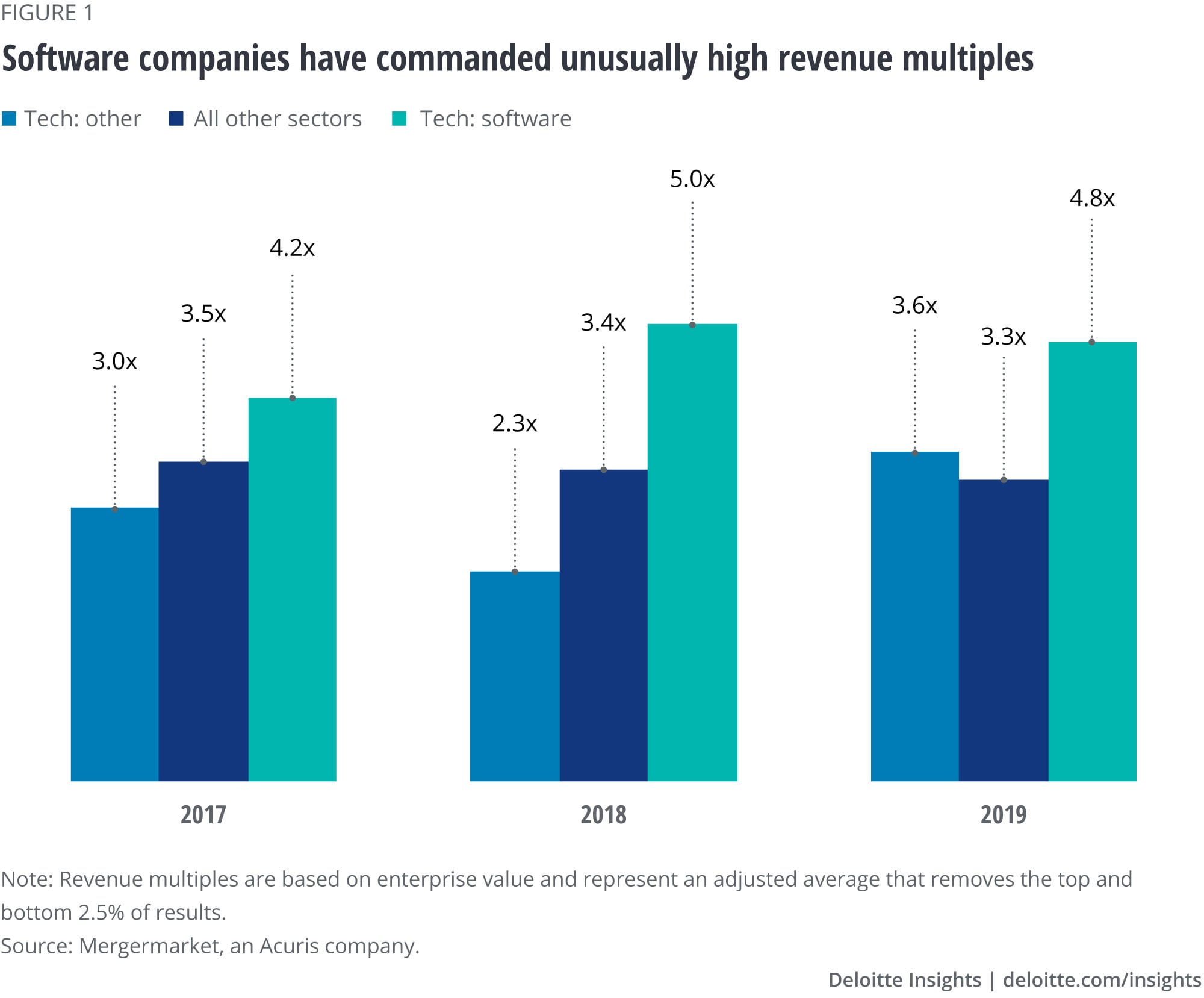Getting more value out of software M&A Software M&A has higher acquisition prices but often fails to meet expectations
3 minute read
10 November 2020
Software firms command high M&A prices but often fail to generate the expected value. How can buyers ensure software acquisitions create value?

Companies have high expectations for software companies—that’s why they have generally commanded higher acquisition prices than targets in other sectors. Since 2017, publicly traded software companies have been acquired at revenue multiples ranging from 4.2x to 5.0x, compared to other sectors’ revenue multiples of 3.0x to 3.6x.
Learn more
Explore the Thinking Fast series library
Subscribe and never miss a charticle
Learn about Deloitte's services
Go straight to smart. Get the Deloitte Insights app
But disappointment often follows: In a recent Deloitte M&A survey, buyers expressed that despite a strong deal environment, acquisitions routinely fail to generate their expected value. Only 7% of corporate development teams felt that their previous deal exceeded their expectations.1
Why do M&A transactions for software companies often fail to meet expectations? Survey respondents reported their top three reasons:
- Their expected sales did not materialize: Standalone revenue did not meet projections.
- They did not achieve expected revenue synergies: Anticipated growth from the transaction fell short of plan.
- There were gaps in integration and execution: Challenges prevented the transaction from realizing its potential value.
According to the survey, the four most common acquisition drivers—product portfolio diversification, technology acquisition, new customer base, and digital strategy—all focus on growth. However, accelerating sales to meet purchase price expectations requires exceptional go-to-market integration, execution, and tight collaboration between the buyer and acquired company, especially across their product and go-to-market teams.
What this means for buyers
Each deal is different, of course, but every buyer can apply key learnings—based on cases we’ve seen—to create value from software acquisitions.
Develop a combined value proposition. A major hardware provider accustomed to selling to large enterprises acquired a series of mid-market software companies. The buyer’s sales force initially perceived the solutions as inferior products, despite their appeal to new or different customer segments. This disconnect shows the need to quickly develop a value proposition that speaks to the combined portfolio’s rationale and customer benefits. This can be followed by companywide product portfolio guidance and field enablement programs.
Prioritize joint product development. While a product portfolio strategy is often embedded in the deal rationale, it takes time to develop a road map that aligns stakeholders on both sides. An enterprise security services company acquired a security platform to accelerate its product road map. Development work was delayed due to misalignment in product integration priorities within the product teams, directly affecting ROI. Acquirers should engage product organizations early to align and prioritize product integration opportunities, with executive alignment from the acquired company.
Jumpstart cross-selling and enablement. Enabling two sales teams to cross-sell effectively requires overcoming strategic, execution, and behavioral challenges with coverage, selling motion, culture, and more. For example, a global technology conglomerate transitioned the acquired company’s account managers to specialist roles, a practice that has been increasingly common in software. But the new specialists rejected the change, perceiving the new role as a demotion due to loss of account ownership. A delicate approach that empowers the acquired company’s sellers in the new role can prevent attrition and incentivize sales behavior that supports post-acquisition revenue growth.
Keep partnerships in mind. Channel partners and technology ecosystems are playing larger roles in software but present their own set of integration challenges. When an enterprise services company acquired a software company targeting the DevOps community, it expected the existing partner ecosystem to accelerate its new purchase’s growth. However, partners were either incapable of or uninterested in investing time to sell the newly acquired company’s products. Scaling through indirect channels takes upfront effort and involves identifying and recruiting the right partners, updating the value proposition, and partner enablement. Acquirers should expect minimal partner contribution initially but should invest time upfront to enable them to scale in the long run.
M&A is costly in time and money, both up front and throughout integration. Leaders can achieve better results for the company and its ecosystem partners through greater planning and communication between acquirer and acquired company, stronger alignment across product and sales teams, and a clear integration and value creation plan.
© 2021. See Terms of Use for more information.
Explore the Technology collection
-
A pragmatic pathway for redefining work Article5 years ago
-
Rediscovering your identity Article5 years ago
-
Tech Trends 2025 Article3 months ago
-
Robots on the move: Professional service robots set for double-digit growth Article5 years ago
-
The AI talent shortage isn’t over yet Article4 years ago
-
The window for AI competitive advantage is narrowing Article4 years ago















